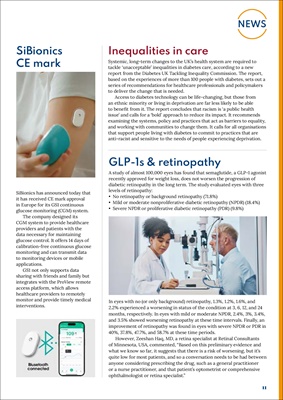
11
NEWS
SiBionics
CE mark
SiBionics has announced today that
it has received CE mark approval
in Europe for its GS1 continuous
glucose monitoring (CGM) system.
The company designed its
CGM system to provide healthcare
providers and patients with the
data necessary for maintaining
glucose control. It offers 14 days of
calibration-free continuous glucose
monitoring and can transmit data
to monitoring devices or mobile
applications.
GS1 not only supports data
sharing with friends and family but
integrates with the ProView remote
access platform, which allows
healthcare providers to remotely
monitor and provide timely medical
interventions.
Inequalities in care
Systemic, long-term changes to the UK's health system are required to
tackle 'unacceptable' inequalities in diabetes care, according to a new
report from the Diabetes UK Tackling Inequality Commission. The report,
based on the experiences of more than 100 people with diabetes, sets out a
series of recommendations for healthcare professionals and policymakers
to deliver the change that is needed.
Access to diabetes technology can be life-changing, but those from
an ethnic minority or living in deprivation are far less likely to be able
to benefit from it. The report concludes that racism is 'a public health
issue' and calls for a 'bold' approach to reduce its impact. It recommends
examining the systems, policy and practices that act as barriers to equality,
and working with communities to change them. It calls for all organisations
that support people living with diabetes to commit to practices that are
anti-racist and sensitive to the needs of people experiencing deprivation.
GLP-1s & retinopathy
A study of almost 100,000 eyes has found that semaglutide, a GLP-1 agonist
recently approved for weight loss, does not worsen the progression of
diabetic retinopathy in the long term. The study evaluated eyes with three
levels of retinopathy:
• No retinopathy or background retinopathy (71.8%)
• Mild or moderate nonproliferative diabetic retinopathy (NPDR) (18.4%)
• Severe NPDR or proliferative diabetic retinopathy (PDR) (9.8%)
In eyes with no (or only background) retinopathy, 1.3%, 1.2%, 1.6%, and
2.2% experienced a worsening in status of the condition at 3, 6, 12, and 24
months, respectively. In eyes with mild or moderate NPDR, 2.4%, 3%, 3.4%,
and 3.5% showed worsening retinopathy at these time intervals. Finally, an
improvement of retinopathy was found in eyes with severe NPDR or PDR in
40%, 37.8%, 47.7%, and 58.7% at these time periods.
However, Zeeshan Haq, MD, a retina specialist at Retinal Consultants
of Minnesota, USA, commented, "Based on this preliminary evidence and
what we know so far, it suggests that there is a risk of worsening, but it's
quite low for most patients, and so a conversation needs to be had between
anyone considering prescribing the drug, such as a general practitioner
or a nurse practitioner, and that patient's optometrist or comprehensive
ophthalmologist or retina specialist."